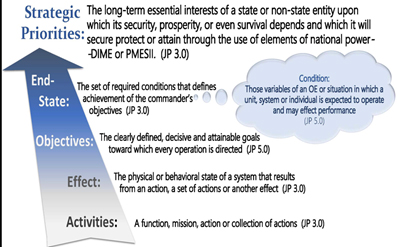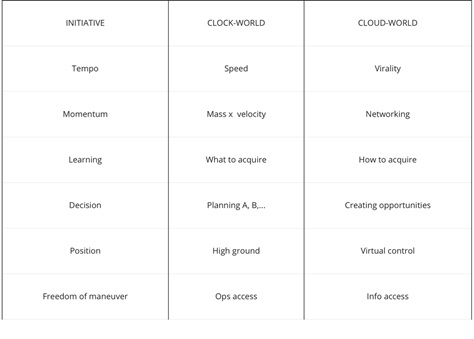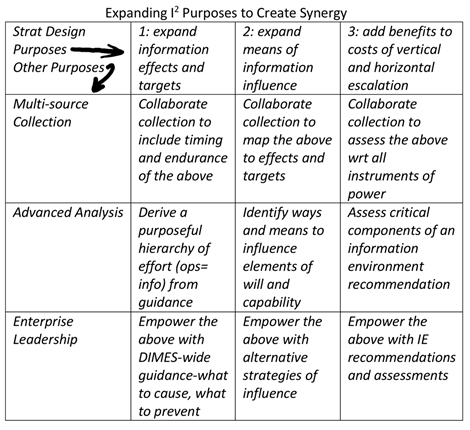Michael D. Phillips and Thomas A. Drohan
Warfare has become all-domain, all-effects, and all-information. This reality is well outside the conventional wisdom of a “threshold of armed conflict.” Operations in and across land, sea, air, space, and the electro-magnetic spectrum (cyber-plus) depend on information and more importantly, create information. Our combined arms approach to warfare focuses on operationalizing information. That is, using information to support all-domain operations. To win wars in the Information Age, we must complete the other half of the job: informatizing operations. That is, we need to use operations to create superior information effects.
We begin by pointing out a logical fallacy that matters: DoD definitions of information (104-105) are circular. That is, they use information to define information. Why care? Because this conceptual failing is an operational failing, too. Information needs to be testable so decision makers can judge the strategic effectiveness of operations. At this level of significance, information effects matter. Superior combinations of diplomatic, informational, military, economic, and social effects (DIMES) win wars from battles. So we turn to Information.
Information
A common shorthand definition for information is, data-in-context. Easy to remember, but we need to specify what it means. Consider this definition that specifies what data is and what context is, in a way that we can assess (measure and test) information:
In other words, processes produce characteristics, to which we can assign values. For instance in a targeting process, we can assign value to characteristics such as location, time, duration, speed, energy, lethality, curability, substance, permeability, or any relevant concept. By defining information in terms of characteristic outputs of processes, we can assess cause and effect relationships. There are many quantitative and qualitative ways to measuring values (see our assessment cube of impact, cost, and trust).
Global information is abundantly uncertain, which is why the definition above is useful. Facing a flood of data, decision makers need information on relevant processes to discern effects of operations. Measures of performance and effectiveness are particularly challenging in diverse contexts. Let’s consider a problematic example of information that we seek, which may be the most politically prevalent: “stability.”
Operations today span a spectrum or continuum of competition filled with cooperation and confrontation. Determining the effectiveness of such operations depends upon their purposes. These need to be specified in clear terms such as, what to prevent and what to cause? Vague purposes are too often misconstrued as different across and within organizations.
We can specify vague purposes, such as stability, by taking a strategic approach to information.
A Strategic Approach to Information
Two basic steps begin this approach.
First, we organize a strategic process that identifies ends, ways and means. We align responsibilities across three levels: the tactical level of engagements; the operational level of campaigns; and the strategic level of policies. We also organize cross-functional and cross-organizational teams to collaborate across and within our otherwise vertically structured bureaucracies. We matrix via operations centers, virtual groups and meetings that bring expertise together.
Second, we value the outputs of operations as tactical, operational, and strategic according to the relative significance of effects. That is, tactical effects are important to the extent they combine to produce operational or strategic effects, and so forth. This assumption is different than valuing tactical, operational and strategic functions as important for their own sake, or to create unit identity. The outputs of operations are ultimately, information.
Taking strategy as a process of ends, ways and means that are valued according to tactical, operational, and strategic levels of significance, we can implement a hierarchy of effort. This is not simply a top down process of alignment. Knowing such intent empowers the development of compliant strategies at multiple levels that are also innovative, decentralized, and agile.
Hierarchy of Effort
We can align priorities according to the following hierarchy of effort: strategic priorities; end state; objectives; effects; and activities:

Diagram 1 (Source: JMark Services Information Environment Advanced Analysis Course)
To achieve the causes and effects in this hierarchy, we need to set desired conditions. Conditions are the outcomes of operations pervaded by uncertainty. Operations in the Information Environment involve complex interactions among causes and effects that are physical, informational, and cognitive. To make sense of this environment, we will treat the hierarchy of effort as two layers: information that gets operationalized; and operations that get informatized.
Operationalized Information. When we regard the hierarchy as operations, information becomes subordinate to running operations. We get the culture and the doctrine that we currently have—courses of action consisting of lines of operations (military) and lines of effort (more-than military). Even at the highest level desired outcomes— strategic priorities—information becomes operationalized. Decision makers want to know what “stability” looks like in terms of operations.
Examples: Markets are open; freedom of navigation is unimpeded; elections are freely conducted; violence is reduced. What do we do next? We keep on operationalizing information, running operations to seize the initiative for operational advantage. Informatized operations are a complementary opposite of this.
Informatized Operations. If we can see the hierarchy as one of information, then operations are subordinate to the information they produce. At the highest level of strategic priorities, “stability” is converted into information—informatized. Decision makers want to know “stability” looks like in terms of the information produced by operations. Unlike most operations themselves, information is ubiquitous and an ever-combining effect.
Examples: Open markets and freedom of navigation and free elections and reduced violence are, at once, disseminated information. How will this combined effect interact and what will it cause? If we wait to react to whatever happens, we lose initiative. Costs rise, too.
We have to gain operational advantage and win the information war. The latter requires recognizing that operations is information.
Operations is Information
The Joint Concept for Operations in the Information Environment helps analyze and holistically grasp operations as information in the three dimensions of the IE previously noted—cognitive, informational, and physical.
Cognitively, intent guides but does not determine behavior. We still estimate intent for many reasons, such as anticipating behavior and targeting perpetrators. But even if we could collect all information, the physics of uncertainty prevents prediction. Human agency and artificial intelligence also produce unexpected behavior. We account for such uncertainty by assessing risk, and benefits. At the same time, we should intend operations to create information. In the minds of a targeted audience, operations must become information.
Informationally, decision makers need “characteristic outputs of processes” (information), to control operations. Joint All-Domain Command and Control, for instance, seeks to develop a common architecture for putting data into context. How? By collecting, storing and processing data into information. Controlling operations depends upon information, but more importantly, the results of operations are information. The killing of a high profile combatant commander, the occupation of disputed territory, and the transit of a warship through international waters—these create new information. When we design a purposeful strategy that owns what it creates, operations are information.
Physically, operations consist of information. Digitized information such as particles and waves can both create new materials such as radioactive isotopes, and destroy them by rearranging their chemical compounds. Creation and destruction should produce operationalized effects and informatized effects. Therefore the value of a creative, destructive, or transformative effect is what strategically matters in an operation. We’ve defined that value as information. So, what do we do with it?
Decision makers have a responsibility to judge the relative priority of information according to a strategy of desired outcomes. For that, we turn to intelligence, a process and product that develops the meaning(s) of information.
Intelligence
Unlike information, the term intelligence does have a disprovable DoD definition (115):
Intelligence — the product resulting from the collection, processing, integration, evaluation, analysis, and interpretation concerning foreign nations, hostile or potentially hostile forces or elements, or areas of actual or potential operations; activities that result in the product; and organizations involved in such activities
A shorthand version of the above definition for intelligence, one that complements the previous definitions of information, is “collecting and thoughtfully processing information.”
Information and intelligence are both contested, so we need to know what information means in that battlespace. To meet this need, we require information intelligence (I2).
Information Intelligence
Information Intelligence - The integrity of contextualized data and processed information.
Information intelligence is a battle against disinformation and deception (and an endless war against uncertainty). The quality of our information intelligence competes as four purposes. All of these are contested in the information environment:
1. Multi-sensor Collection - Acquire and place vast amounts of data into decision makers’ contexts. This creates information. The collection competition is fundamental to our ability to gain situational awareness. The collection competition comprises sensors-in-context, from national technical means to human collectors. We should have a seamless interface among collectors, analysts and operators to ensure collection requirements meet the needs of planners, strategists, and decision makers.
2. Advanced Analysis -Aassess the meaning of information (intelligence) to expand opportunities for commanders to seize the operational initiative, rather than react to adversary actions. All of the “INTs” comprise this critical competency. The analysis competition should be recognized as an ongoing war of wits to connect actors’ motives through linkage analysis, maintain actionable baselines through pattern analysis, and anticipate surprises though anomaly analysis and forecasting.
3. Strategic Design - Integrate intelligence into desired and anticipated outcomes amenable to being influenced. This tradecraft of strategy should broadly consider all available and appropriate tools to target-for-influence the will and capability of actors and systems for effects. This effects-targets-tools design competition should aim to operationalize and informatize the hierarchy of effort better than adversaries.
4. Enterprise Leadership - Develop proactive leaders at every level of the information intelligence enterprise. The art and science of multi-sensor collection, strategic analysis and strategic design enhances the strategic language among senior leaders. Just as joint doctrine and effects-based operations force platform-specific subcultures to value the effects of capabilities, information intelligence puts the integrity of desired effects at the forefront of strategy.
These applied purposes of information intelligence are crucial to superior strategy in a broadly contested environment. Indeed, adversaries practice all manner of all-domain all-effects warfare (chaoxianzhan [unrestricted], kompramat [blackmail], dunoejeon/jihyejeon [xxvi, brains/wits]). Next, we show how to use information intelligence to amplify desired effects for strategic gains.
Informatizing Fights for Strategic Gains
As detailed above, there are four fights in information intelligence—data collection, intelligence analysis, strategic design, and leadership development. They produce synergistic results — good or bad, desired or not — because they interact with each other. Expanding the scope of each fight can create strategically advantageous information out of operations.
To suggest how, we have selected publicly available information on United States Air Force Special Operations Command’s (USAFSOC) strategic guidance. This guidance is forward-looking and lends itself to fusing our four purposes of information intelligence. We will do this in two steps.
First, we apply strategic design to recommend expanding USAFSOC’s three focus areas for the future fight. That future is already here in the form of adversary combinations of effects, targets and tools. Such an expansion of responsibilities will not be specific to USAFSOC. Other organizations can apply their capabilities for strategic gains.
Second, we enhance the recommendations with the other three purposes of information intelligence—multi-sensor collection, advanced analysis, and enterprise leadership—all of which interact with each other.
Strategic Design to Expand Options
1. AFSOC will employ low-visibility capabilities to identify high-value targets in denied areas and contribute to the joint force’s ability to link those targets with desired effects.
Recommendation. Expand the types of effects by including non-denied areas such as public and virtual spaces. Expand the definition of high value targets to include any permissibly targeted will and capability to achieve desired information effects.
2. AFSOC will leverage its access and placement to provide organic all-domain fires to open windows of opportunity the joint force can then exploit with mass.
Recommendation. Expand fires to include any permissible means of influencing will and capability. Consider principles besides mass that can exploit opportunities, differently so in mechanical-operational and digital-informational environments. The following table breaks ”initiative“ down into supporting components, only one of which is mass. To achieve initiative across all domains, we need: (a) more means than fires; and (b) fires to generate desired information.
Components of Initiative in Different Aspects of the Information Environment

3. AFSOC will provide the joint force unique options to impose costs and hold adversaries at risk outside immediate conflict zones with a comparatively low risk of horizontal escalation.
Recommendation. Add benefits to costs and risks, to include horizontal escalation where advantageous. DIMES-wide horizontal escalation could include diplomatic pressure, informational attacks, military advisors, economic sanctions, and social opposition. Each of these can go vertical, respectively, in terms of decision maker involvement, information momentum, scope of military advice, individualized sanctions, and support for social opposition.
Multi-sensor Collection, Advanced Analysis, and Enterprise Leadership to Enhance Options
The following table illustrates how to expand and synergize purposes for greater effects, in two steps. We take one type of purpose, in this case the three recommendations for strategic design (across the top of the table). Then we enhance those recommendations with the other three purposes (down the left side of the table):

Table 2
This strengthening exercise could go on, developing a recommendation for each of the other three types of purposes, and enhancing each recommendation with the other purposes.
Purposes need to be combined if they are to produce synergistic effects. Collaborative collection is needed to analyze data and information into intelligence for complex contexts. Advanced analysis needed to provide leadership competitive strategies against advanced persistent threats. Enterprise leadership is needed to empower all of this to happen.
Applications to Cyber and Space
Using a hierarchy of effort and four purposes of information intelligence, we showed how to produce synergistic effects with informatized operations. Our demonstration of USAFSOC’s strategic guidance can be applied to other organizations. Let’s briefly explore US Cyber Command and the US Space Force.
US Cyber Command can expand deterrence by denial and deterrence by punishment, to include other desired outcomes. The US Cyberspace Solarium Commission Report, a Congressional mandate released this month, outlines requirements for a comprehensive cyberspace security policy, such as layered cyber deterrence. Unpacking what that means, we see cyber security, electromagnetic spectrum defense, strategic narratives, economic sanctions, legal indictments, and diplomatic persuasion and dissuasion. The desired synergy of effects is more than deterrence. The combined effect is deter-defend-secure-dissuade-persuade-compel-coerce. Deterrence by denial involves defending, dissuading, persuading, and securing. Deterrence by punishment involves compelling and coercing.
The US Space Force can develop more than force-enabling effects from, through, and in space. A recent RAND study identifies required capabilities, along with acquisition and headquarters activities: space control; space situational awareness (SSA); positioning, navigation, and timing (PNT); ISR; SATCOM; missile warning; space-based nuclear detonation; environmental monitoring; space launch and range operations; and satellite operations. The Space Force’s “separate identity” is arguably best for the nation by being distinctive rather than unique: an enabler of combined effects. As in cyber, our broad dependence on this domain’s assets extends well beyond a need for deterrence and defense. Inaugural Space Force commander General John Raymond’s call for rapid launch capability and common architecture complements the Solarium Commission’s directive for a joint collaborative environment and planning cells to protect critical infrastructure.
The mission requirements of USAF Special Operations Command, US Cyber Command, and the US Space Force have the potential to synergize a broad range of national security priorities via information intelligence. Multi-sensor collection, advanced analysis, strategic design, and enterprise leadership can amplify strategic effects beyond operational advantages.
What will we do with emerging technologies such as hypersonic reach, resilient ISR and communications, survivable strike and global mobility, and high-speed vertical lift?
New technology offers new capabilities to achieve operational effects. All-domain operations are focused on that part of warfare. How well we informatize operations is the other half that wins all-effects wars, which are already here.
No comments:
Post a Comment